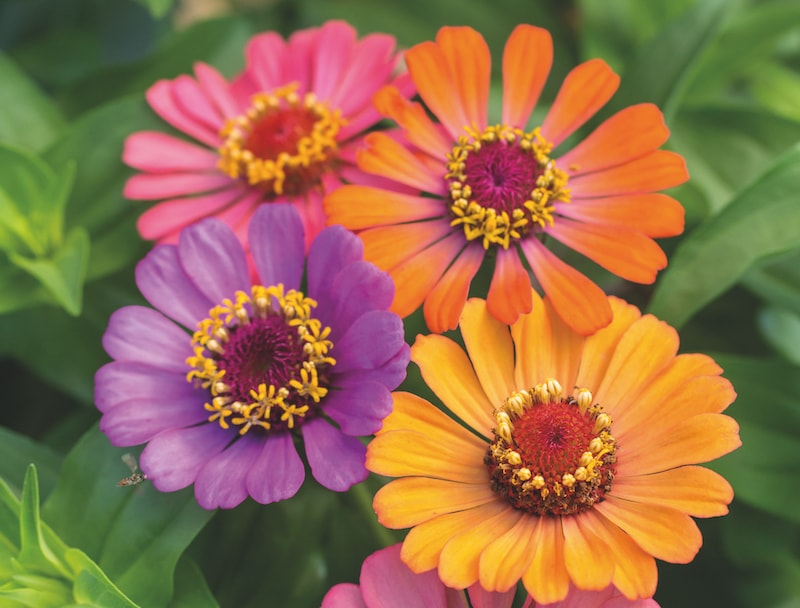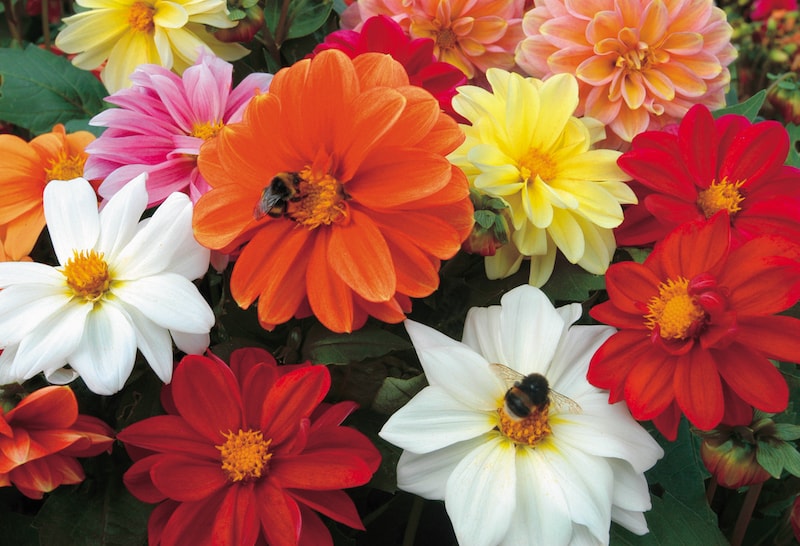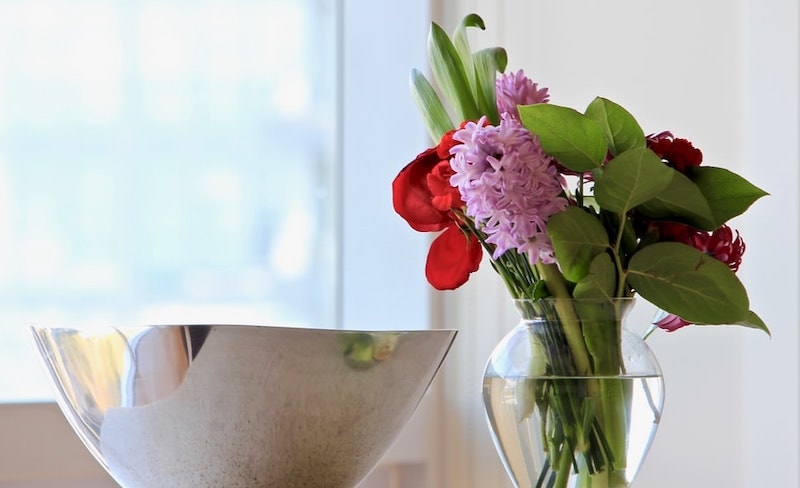Growing your own cut flowers allows you to focus on the colours and textures you want while avoiding supermarket blooms that may have travelled miles to reach the shelves. You don’t need loads of space, in fact you can sow your flower seeds in containers and window boxes or even amongst your veggies.
The following cut flower chart is a fantastic way to plan which flower varieties to grow and when! If you want to fill your home and garden with gorgeous cut flowers, this handy guide is an excellent resource to help you succeed.
Key:
- Hardy Annual (HA) – Growing from seed, hardy annuals bloom, set seed and die in just one growing season. They need to be re-sown each spring, but many can be direct sown outside and bloom right through to autumn.
- Half Hardy Annual (HHA) – These flowers bloom the first year from seed. Although they can handle light frost, half-hardy annuals can’t survive extremely cold weather. Start them indoors with a little gentle heat and plant outside in spring or summer.
- Hardy Biennial (HB) – A biennial grows foliage during its first year, survives through the winter, and then finally blooms in the second season. Once it has bloomed and set seed, it dies.
- Hardy Perennial (HP) – Perennial flowers live for a number of seasons. They may not always bloom the first year from seed and most tend to flower for a short period – between 1-3 weeks a year. They need periodic rejuvenation and/or replacement every three to five years.
- Half Hardy Perennial (HHP) – You may see this term used on Suttons seed packets to indicate that this perennial plant is often grown as an annual because it’s killed by winter frosts if not protected. If you live in a frost-free climate, this plant would be perennial for you.
Cut flower wall chart
| Name | Type | Sow | Flowers | Comment |
|---|---|---|---|---|
| Achillea | HP | Jan – Mar | Aug – Oct | Dries easily, lasting bright & pastel shades. |
| Ageratum | HHA | Feb – Mar | All summer | Compact flowers, good for posie vases. |
| Alstromeria | HP | May – June | June – Aug | Following year Excellent cut flower that has an amazing vase life. |
| Amaranthus | HA | Mar – May | July – Sept | Great for cutting and drying, very dramatic blooms. |
| Anemone | HP | Jan – June | Spring – early summer | Bright and cheerful, superb cut flower. |
| Antirrhinum | HHP | Jan – Mar | All summer | Gives height to any floral display and very pretty. |
| Aquilegia | HP | Jan – Mar | May – July | Following year Cottage garden favourite that will give height to a floral display. |
| Aster | HHA | Apr – Mar | Late summer to autumn | An excellent cut flower with superb vase life. |
| Basil (foliage) | HHA | Apr – May | Throughout summer | As with most herbs, great for foliage and dries well. |
| Calendula | HA | Mar – June | May – Aug | Long flowering and good cut flower. |
| Carthamus | HA | Mid Mar-May | July – Sept | Thornless – makes a great cut flower either fresh or dried. |
| Catananche | HP | Feb – June | Mid April Following year | Good for cutting and drying as an everlasting flower. |
| Celosia | HHA | Feb – April | Throughout summer | Fiery plumes of flowers. |
| Christmas Rose | HP | Mar – June | Nov – Dec | Attractive winter flowers with evergreen foliage. |
| Chrysanthemum | HA | April – July | Aug – Oct | Long lasting filler flowers. |
| Cineraria (foliage) | HHA | Jan – Mar | Throughout summer | Silvery background for smaller displays and posies. |
| Clarkia | HA | Mar – May | May – July | Very pretty clusters – easy to grow. |
| Coreopsis | HA/HP | Feb – Mar | July – Oct | Ideal for mixed borders and cutting. |
| Cornflower | HA | Mar – May | June – Sept | Cottage garden favourite with long wiry stems. |
| Cosmos | HHA | Mar – May | Late summer | Great for in borders or as a cut flower. |
| Dahlia | HHP | Jan – Mid April | July – Sept | Interesting blooms, invaluable for autumn floral arrangements. |
| Delphinium | HP | Mid Jan – Mar | Aug – Sept | Spectacular cut flowers for height and texture. |
| Dianthus | HHA | Jan – Mar | July – Sept | Fragrant and colourful, good for small posies. |
| Digitalis (Foxglove) | HB | April – Mid July | June – Mid Aug Following year | Sturdy cottage flower gives height to both formal and informal displays. |
| Emilia | HA | April – May | July – Sept | Fluffy bright flower heads held in clusters on long, slender stems. |
| Eryngium | HA | March – May | July – Sept | Pineapple – Ideal for cutting and drying. |
| Freesia | HHP | Mar – June | Nov – Mar | Very fragrant and a popular choice for floral displays. |
| Gaillardia | HP | May – July | July – Sept | Spectacular daisy like blooms that are great for cutting. |
| Gazania | HHP | Feb – April | June – Sept | Vibrant flowers that are an attractive focal flower. |
| Geum | HP | Jan – Feb | June – Oct | Luminous orange and yellow flowers on upright stems. |
| Godetia | HA/HHA | March – May | July – Sept | Pretty blooms – good filler for informal displays. |
| Grasses | HA/HP | Mid Mar – May | Mid June – Mid Sept | Lovely textured foliage filler – good dried for winter displays. |
| Gypsophila | HA | Mar – May | June – Sept | Delicate froths of tiny flowers – a must for floral arrangements. |
| Helichrysum | HA | March – May | July – Oct | Colourful winter dried flowers, to dry – cut when just open. |
| Heuchera | HP | April – July | June – Aug (Year 2) | Subtly scented blooms that can be cut for indoor decoration. |
| Hollyhock | HP | April – June | June – Aug | Magnificent summer flower- dries well for winter colour. |
| Kingfisher Daisy | HHA | March – May | June – Sept | Pretty chrysanthemum-like flowers – for posies. |
| Kochia | HA | Mar – April | Summer – autumn | Stunning foliage, pale green in summer – copper in autumn |
| Larkspur | HA | Mar – May | Throughout summer | Long splendid stems of flower – useful for height and depth, dries well. |
| Lavatera | HA | Mid Mar – May | July – Sept | A stunning filler for larger displays. |
| Lavender | HP | Jan – June | June – Sept | Beautifully scented, good colour and dries well. |
| Linaria | HA | Mar – May | Throughout summer | Easy to grow, flowers like little snapdragons in bright colours. |
| Linum | HA | Mar – April | June – Sept | Pretty filler flowers. |
| Love-Lies-Bleeding | HA | Mar – May | July – Sept | Stunning tassel like flowers – adding rich texture to larger displays. |
| Lupin | HP | Mid Mar – May | June – Sept | Following year Ideal for cutting – gives a cottage garden feel to taller displays. |
| Malope | HA | Mid Mar – May | July – Sept | Pretty open blooms – useful for smaller posies. |
| Marigolds | HHA | Feb – Mid May | July – Sept | Great for informal displays – dries well. |
| Michaelmas Daisy | HP | May – July | June – Oct | Following year Cheerful daisies – good for informal summer displays. |
| Mignonette | HA | Mar – May | July – Sept | Pretty small headed flowers – ideal fillers for smaller displays. |
| Moluccella | HHA | Feb – Mar | May – June | Green graceful stems – excellent for all displays. |
| Nasturtium | HA | Mar – May | Mid June – Sept | A riot of colour – great for informal small displays and posies. |
| Nicotiana | HHA | Mid Mar – May | Mid June – Sept | Fragrant and charming, good for informal arrangements. |
| Nigella | HA | Mid Mar – May | July – Sept | Delicate flowers – lovely for informal displays – pods and flowers dry well. |
| Penstemon | HHP | Feb – Mar | May – Sept | Pretty summer spires that add substance to larger displays. |
| Phlox | HHA | Feb – April | June – Sept | Dainty heads of flowers – lovely in summer informal displays. |
| Poppy | HA | Jan – Mar | June – Oct | Not long lasting however blooms make beautiful focal flowers – pods dry well for winter decoration. |
| Pyrethrum | HP | May – July | May – June | Following year Lovely long stemmed daisy flowers – ideal for informal fillers. |
| Rudbeckia | HHA/HP | Feb – Mid April | July – Sept | Superb daisy like flowers – great long lasting focal flowers. |
| Salvia | HHA | Jan – Mar | July – Sept | Wonderful filler flowers that provide shape and texture. |
| Scabious | HP | Mid Mar – May | July – Sept | A superb traditional flower that will add grace to any display. |
| Statice | HHA | Feb – April | July – Sept | One of the best plants for cut/dried flowers. |
| Stock | HHA | Feb – April | June – Sept | Fragrant classic flower – stunning in formal and informal displays |
| Sunflower | HA | Mar – May | July – Sept | Easy to grow – a must for flower arranging – dries well. |
| Swan River Daisy | HHA/HA | Mar – May | June- Sept | Easy to grow – fragrant, lavender blue flowers. |
| Sweet Pea | HA | Jan – May | June – Sept | Popular cottage garden flowers that look stunning in a floral arrangement. |
| Sweet William | HB | May – July | June – July | Following year Scented cottage garden flower – classic focal flower. |
| Wallflower | HB | May – Mid July | April – May | Following year Cheerful scented flowers – lovely in informal displays. |
| Zinnia | HA | Mar – May | July – Sept | Stunning blooms that provide excellent focal interest and texture – dry well. |
How to pick cut flowers

Image: Zinnia Seeds – Molotov Mix from Suttons
- Don’t pick cut flowers in the heat of the day or they will wilt. Try first thing in the morning or wait until last thing at night.
- When you pick annuals and biennials, don’t cut them down to the ground. To encourage more flowers, take out the leading shoot, cutting just above a side branch with a bud. Remember that you can cut the stem as long as you like, but always make sure that you leave buds below the cut.
- Don’t arrange freshly cut flowers straight away. To increase their vase life, cut and plunge the stems straight into a bucket of tepid water and allow them to recover for a few hours first.
- Move the bucket to a shady spot while the flowers rest. Don’t leave them in direct sun.
- When you’re ready to start arranging, remove the leaves from the bottom half of the stem so they don’t rot in the vase. Also, fewer leaves place less demand on the stem and the flower is less likely to flop.
How to make cut flowers last longer

Image: Dahlia Plants – Figaro Mix from Suttons
If you want your arrangements to last as long as possible, always add flower food to the water in your vase. You can buy it in sachets, or you can make your own from sugar, bleach and lemon juice or vinegar. For a 30cm tall vase, the proportions are as follows: one tablespoon of sugar, one teaspoon of bleach, and one tablespoon of clear malt vinegar or lemon juice. This homemade recipe helps to prevent the build up of harmful bacteria that can shorten the vase life of your flowers.
Month-by month flower growing guide

Image: Sunflower Seeds ‘Tiger Eye F1’ from Suttons
- JANUARY – There’s not a lot to see in the garden this month, however, it’s a good time to walk around the garden to check your plants. Make sure they’re still well anchored in the ground if you want to keep them. Start getting ideas for your spring planting area and order your seeds for spring sowing.
- FEBRUARY – Sow half hardy annuals (HHA) indoors. Prepare your outdoor soil by digging it over so the soil is very fine (no hard clumps of mud). The term used for very fine soil is tilth, and this is perfect preparation for sowing seeds direct into the soil.
- MARCH – In most areas, you can now sow hardy annuals (HA) when all risk of frost has passed. These can be scattered in informal drifts or sown into drills made by drawing a rake through the soil. Cover lightly with soil and water well. (Try Nigella, cornflower and larkspur.) Seeds of tender annuals (TA) can now be sown in a greenhouse or on a warm windowsill out of direct sunlight. (Try aster, antirrhinum and cleome.)
- APRIL – Continue to sow hardy annual seeds where you want them to grow. The hardy annuals that were previously sown can now be thinned by removing the weaker plants. This allows the stronger plants to develop into strong flowers.
- MAY – Sow seeds of tender annuals like sunflowers and cosmos in the position you want them to flower and keep them well watered. Tender perennials (TP) that have been growing in an indoor environment can now be hardened off by moving them outside on warm sunny days.
- JUNE – Sow seeds of hardy biennials (HB) in trays in a heated greenhouse. The seedlings can be potted individually and grown on ready for planting out next spring. Pick sweet peas regularly as soon as the flowers open – this prevents seed pods forming and encourages more flowers. Cut the stalks at the base where they join the main stem.
- JULY – Keep plants well watered in dry spells. The best time to water is in the evening allowing the plant to soak up what it needs overnight. Thin last month’s biennials to give a final spacing of about 30cm (12″) so that they will grow into sturdy plants.
For more specific tips on growing flowers, see our Flower Growing Guides for inspiration and advice.
Lead image: Shutterstock




Hi,
Really happy to say your post is very interesting to read. I never stop myself to say anything about it. You’re doing a great job. Keep it up. We recognized as one of the leading professional providers of integrated flower services in the MENA region. Check our page, “https://www.coventgardenuae.com/”. Expecting more blogs.
Nice post
Hi there, thank you for your kind comment. We are pleased it has been helpful to you.
Best regards,
The Suttons Team
This article is very helpful for our website. Thank you for share this article.
Your topic is very nice and helpful to us … Thank you for the information you wrote.
just whats needed I am getting desperate cos winter is still with us and I need some summer colour, so word to self,
order seeds.
Love the information. But being a novice would have liked a chart showing at a glance what flowers when instead of just an alphabetical list of flowers.
Many thanks for your kind words Barry and congratulations on being the first to comment. I know our web developer’s extremely pleased as he spent a great deal of time and effort making sure the article was full of content and also looked good on all modern devices!
Out of interest, which cut flowers did you choose for your refit?
A very helpful chart, I wish I’d found it earlier as it would have made my garden refit so much easier (and probably more successful straightaway).